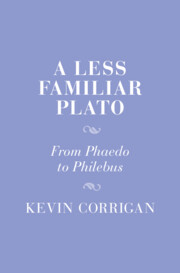Book contents
- A Less Familiar Plato
- Cambridge Studies in Religion and Platonism
- A Less Familiar Plato
- Copyright page
- Contents
- Acknowledgments
- Abbreviations
- Introduction
- Part I Embodiment and Participation in the Divine
- Part II Introduction to the Republic and Philebus
- Part III Introduction to Love, Myth, Erotikē Technē, and Generative Epistēmē
- 7 Love and Myth
- 8 Desire, Love, and Friendship
- 9 The Many Questions of Plato’s Phaedrus
- 10 General Conclusion
- Appendix Scientific Perception or Sharp Seeing in the Middle and Late Dialogues
- Primary Texts
- General Bibliography
- Index
9 - The Many Questions of Plato’s Phaedrus
Did Plato Write a Commentary on His Own Work?
from Part III - Introduction to Love, Myth, Erotikē Technē, and Generative Epistēmē
Published online by Cambridge University Press: 26 October 2023
- A Less Familiar Plato
- Cambridge Studies in Religion and Platonism
- A Less Familiar Plato
- Copyright page
- Contents
- Acknowledgments
- Abbreviations
- Introduction
- Part I Embodiment and Participation in the Divine
- Part II Introduction to the Republic and Philebus
- Part III Introduction to Love, Myth, Erotikē Technē, and Generative Epistēmē
- 7 Love and Myth
- 8 Desire, Love, and Friendship
- 9 The Many Questions of Plato’s Phaedrus
- 10 General Conclusion
- Appendix Scientific Perception or Sharp Seeing in the Middle and Late Dialogues
- Primary Texts
- General Bibliography
- Index
Summary
Any reading of the Phaedrus presents many questions, some of which have arguably never received an answer from antiquity down to the modern age, despite recent fine commentaries, those, for example, of Capra, , and especially Werner, . Among these questions are the following: What is the structure of the Phaedrus? Is it really a divided dialogue that contradicts its own stipulations for good writing (264b–c: “every speech should be put together like a living creature with a body of its own … not without head or feet … with middle parts and extremities, written as appropriate to each other and to the whole”)? The Phaedrus, by contrast, seems puzzling. If there is a principle of structural unity in it, what is this principle or principles? Why does the first part of the dialogue – namely, the three early speeches about love culminating in Socrates’ great palinode, not carry over into the second part that deals much more prosaically, first, with rhetoric and, second, with living speech and a critique of writing?1
- Type
- Chapter
- Information
- A Less Familiar PlatoFrom Phaedo to Philebus, pp. 240 - 278Publisher: Cambridge University PressPrint publication year: 2023



